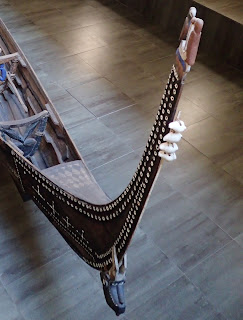On a trip to Italy this month, we visited the Vatican Museums, eager to see masterpieces like the Laocoon group and the Apollo Belvedere. Upon entering, however, the first thing we saw was this plank-built canoe, an eye-catching introduction to an extensive temporary exhibit of boat models and paddles from around the world.
The Vatican's stated purpose for the exhibit is to represent of the diversity and interconnectedness of world cultures. The curators were far more interested in communicating that ecumenical message than in the details of the items on display, for we saw nothing to identify the boat or paddles on exhibit, and the models were accompanied by only scanty information. Nevertheless, we'll concentrate on the exhibit's sole full-size boat in this post, and move on to the paddles and models in subsequent posts.
We believe the canoe is from the Solomon Islands. Haddon and Hornell (in Canoes of Oceania, Vol. 2) identify four types of plank-built monohull canoes in the Solomons. Those with continuous washstrakes like the one here were called mon and were characteristic of the central Solomons, including Bougainville, New Georgia, and Choiseul.
In contrast, canoes called lisi, with discontinuous washstrakes both fore and aft, were characteristic of the southern part of the chain (including Guadalcanal, Malaita and San Cristoval) and of the tiny island of Buka, at the chain's northernmost end. With the exception of its discontinuous washstrakes, the following image of a Buka canoe observed in 1753 by Labillardiere is very much like the canoe in the Vatican. (See also our post on a Solomon Islands canoe at the Peabody Museum of Archaeology and Ethnology, which we now recognize as a lisi.)
The exhibit canoe is built of long parallel planks with no keel. Each plank is gotten out with cleats left standing proud on its interior surface near the lower edges, one cleat per rib. These cleats are lashed to ribs with vegetable fiber and caulked with resin made from the "putty nut" (Parinarium laurinum).
Most of the ribs are roughly round in section and appear to be bent to shape, their top ends being carved with faces that are decorated with eyes of shell inlay. The two forward-most frames and accompanying thwarts are carved from single pieces of wood, and painted, carved decorative elements appear within that perimeter. Continuous thwart risers are lashed to the ribs and run nearly the whole length of the boat, supporting multiple seats for paddlers and passengers.
The most distinctive feature of the canoe is its tall, elaborately decorated prow and stern. The outboard surfaces of these features are inlaid with thousands of pieces of carved shell in circle and cross patterns, and the decks feature diamond-pattern shell inlays. A grotesque painted and carved animal head (a goat? a demon?) sits right at the waterline on the cutwater with its horns on either side of the stem. Cowry shells are lashed to the fronts of both the stem and sternpost high above the waterline. The stem is capped with a painted carving of two parrot-like birds facing one another over a bulb-topped post that might represent fruit on a tree. The sternpost also features a painted carving at the top of an obscure geometric design.
Sources:
Canoes of the Solomon Islands by R.J.A.W. Lever.
"Canoes of the Solomon Islands," from The Maori Canoe by Elsdon Best
Canoes of Oceania, Vol. II: The Canoes of Melanesia, Queensland, and New Guinea, by A.C. Haddon and James Hornell
| Stern view of a Solomon Islands mon canoe at the Vatican. (Click any image to enlarge.) |
 |
| Bow of the Solomon Islands mon canoe at the Vatican. |
We believe the canoe is from the Solomon Islands. Haddon and Hornell (in Canoes of Oceania, Vol. 2) identify four types of plank-built monohull canoes in the Solomons. Those with continuous washstrakes like the one here were called mon and were characteristic of the central Solomons, including Bougainville, New Georgia, and Choiseul.
In contrast, canoes called lisi, with discontinuous washstrakes both fore and aft, were characteristic of the southern part of the chain (including Guadalcanal, Malaita and San Cristoval) and of the tiny island of Buka, at the chain's northernmost end. With the exception of its discontinuous washstrakes, the following image of a Buka canoe observed in 1753 by Labillardiere is very much like the canoe in the Vatican. (See also our post on a Solomon Islands canoe at the Peabody Museum of Archaeology and Ethnology, which we now recognize as a lisi.)
 |
| "Buka Island Canoe (Solomon Islands)" from Labillardiere (1800), Atlas pour servir a la relation du voyage de la recherche de la Perouse. (Source: University of Cambridge) |
| Bent (?) frames amidships, with decorative carving at the upper ends, are lashed to cleats on the planks' interior surface. Also in view is the seat riser. |
 |
| Carved frame/thwart units near the bow. |
 |
| Bow detail showing a carving of a horned beast (or demon?) at the waterline, extensive shell inlay, and cowry shells lashed to the forward surface of the stem well above the waterline. |
| Carved stem-head decoration |
Sources:
Canoes of the Solomon Islands by R.J.A.W. Lever.
"Canoes of the Solomon Islands," from The Maori Canoe by Elsdon Best
Canoes of Oceania, Vol. II: The Canoes of Melanesia, Queensland, and New Guinea, by A.C. Haddon and James Hornell









